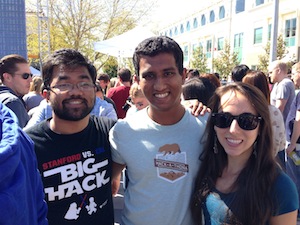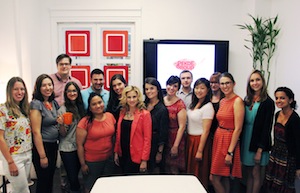For an older generation, “business casual” may have meant “no ties required on Friday”. But now that less-formal dress is more common in so many workplaces, business casual can be a cryptic term to crack.
Illustration by Nick Criscuolo.
This post originally appeared on LearnVest.
Dress codes are catching up with the modern emphasis on work-life balance and the need to blend the personal with the professional, explains LearnVest human resources associate Sarah DeGrazia. “I think business casual exists to make people feel more comfortable and be their most productive selves,” she says. “It reflects a cultural shift toward being more relaxed.” According to DeGrazia, business casual for men usually means skipping the suit and tie in favour of dress pants, a collared shirt and a belt. But when it comes to women, settling on a no-fail business casual outfit is more difficult.
Generally, women can wear any type of skirt or dress with a hem that goes past the knee, as long as the cut isn’t too revealing on top, or a tailored pair of dress pants with a button-down or blouse. Closed-toed shoes are a must, though both heels and flats are acceptable. If you don’t know what to expect in a new job, DeGrazia recommends asking a friend in the field. She also sees no harm in asking your team members or boss, as long as it’s not the night before the interview. Today many companies also have websites or social media accounts that feature their employees, so do your homework.
As for business-casual don’ts? Generally speaking, “no jeans, no sneakers, no flip-flops, no sweatshirts,” says DeGrazia. (Though, if you happen to work in Silicon Valley — or an industry like it — the opposite might be true.) If in doubt, consider playing it safe by opting for something more formal. “I can’t imagine a situation in which a candidate would be penalised for overdressing,” DeGrazia assures us. “Even if you show up in a suit and everyone else is wearing jeans, you can always remove the jacket. Especially in an interview setting, you never want something under your control — like your outfit — to act as a distraction.”
Still, what’s appropriate can vary by industry, age and even location. While tech employees can often get away with jeans and tees, a job in finance most likely means a suit and tie every day. Each industry has their norms, so we asked four professional in different fields: What does “business casual” mean for you?
The Techie
Name: Vihang Mehta, 23, Menlo Park, Calif.
Industry: Technology

As a software engineer at Facebook, Vihang Mehta’s office wear is more casual than business casual. He says that jeans and T-shirts are the norm for everyone from lower-level employees to big bosses — C.E.O. and founder Mark Zuckerberg hardly wears anything else.
Outfits do vary by each employee’s personal preference, and some people opt to go slightly more formal. But the majority of employees are fairly young, and most stick with casual wear — even those who meet clients. Mehta says his office even does “Corporate Fridays” as a fun twist on the old office tradition. “People dress up just for fun, or wear a suit.”
The Consultant
Name: Myles Miller, 50, Harrisburg, Penn.
Industry: Professional Training Development

Around the offices of education and training consulting firm LeadUp, the dress code is all about what employees feel comfortable wearing, says founder and C.E.O. Myles Miller.
But Miller points out that employees, including himself, spend no more than 10 hours per week at headquarters. Most of their services are performed on-site at the offices of other companies, which means they need to be dressed appropriately for industries such as defence, pharmaceuticals, retail, hospitality, government and manufacturing. “That’s something I’ve seen changing over the past few years,” Miller adds. “How you dress really does depend on who you’re going to see.”
If Miller is booked for a speaking engagement, he always checks the dress code with the event planners — although he’s noticed that even some of the Fortune 100 companies he’s worked with are moving toward more casual daily attire. But he always wears a suit and tie when he first meets a client: “I’m still somewhat of a traditionalist,” he says.
The Ad Exec
Name: Amanda Pekoe, 33, New York City
Industry: Marketing & Advertising

Amanda Pekoe (wearing the bright blazer at left), C.E.O. and founder of theatrical marketing and advertising company The Pekoe Group, aims to keep her office dress code professional and fun at the same time. She asks that her employees — all under age 35 — sport orange or red, the company’s official colours, when they’re in front of clients. “It can be something simple, like an orange blazer or necklace for the ladies, and for the men, a tie or pocket square,” she says. “I want everyone to look professional, but I don’t want them to look too stuffy.”
Her personal go-to outfits include button-down silk blouses with a pair of dress pants or nice jeans, a blouse with a blazer or a dress with a cardigan. Pekoe mostly sticks with flats for comfort, but if she wears heels, opts for wedges instead of stilettos. “I would say 99% of the time I’m rocking a big statement necklace,” she says. “Usually the women in the office are using accessories and jewelry as a way of pull the whole look together and make it feel business-y, but also hip and trendy,” she adds, while “the guys rock out really fun shoes” or spice up an outfit with colourful socks or bowties.
The Finance Guy
Name: Julian Gilliatt, 22, New York City
Industry: Corporate Finance

For Julian Gilliatt, a financial analyst at Bloomingdale’s corporate offices, business casual means something more formal. On any given day, he wears a dress shirt and dress pants — brown usually, black when he wants something more conservative — with a matching belt and shoes. He swaps in a linen shirt for the office’s casual Friday.
Business formal is the dress code at the VP level, with execs wearing a suit and tie. In special situations, like dinner with colleagues, choosing the appropriate attire can be tricky, Gilliatt says. “It’s dependent on the personality of your team,” he advises. “You could be going to a nice dinner with your boss and dress business formal, but if your boss is taking you and your team out for drinks or something, then it’s much better to go casual than be completely overdressed.”
What Does “Business Casual” Really Mean? 4 Employees Share What They Wear [LearnVest]
Alexa Pugh is an editorial intern at LearnVest and Senior Editor at the Brown Daily Herald.

Comments